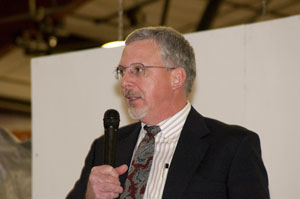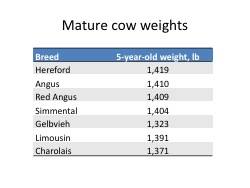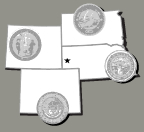Cow Size & Expenses
Extension specialist Ken Olson considers the cow side of producing 1,000-lb. feeders.
by Troy Smith for Angus Productions Inc.

Ken Olson
MITCHELL, Neb. (Nov. 29, 2011) — It is commonly understood that cows are getting bigger. In a presentation at Range Beef Cow Symposium XXII in Mitchell, Neb., South Dakota State University (SDSU) animal scientist Ken Olson said indicators, including the shift in expected progeny difference (EPD) genetic trends for animal weights and direct comparison of cow weights at the USDA Meat Animal Research Center (MARC), support the assumption.
Olson said the old rule of thumb suggesting similarity between mature cow weight and live harvest weight of progeny also indicates cow size is trending higher. Again citing MARC data, Olson said the average cow weight for three popular British breeds and four Continental breeds is nearly 1,400 pounds (lb.). However, contrary to commonly held perceptions, cow size for British breeds is a bit bigger than that of Continental breeds.
It is a fact, said Olson, that nutrient requirements increase as the size of an animal increases. However, nutrient requirements increase more directly as a function of body surface area, rather than body weight. So, nutrient requirements, in terms of net energy for maintenance (NEm), rise as a function of body weight to the ¾ power. Accordingly, explained Olson, a 1,400-lb. cow’s requirement is about 11% higher than a 1,200-lb. cow's, even though she is about 16% heavier.
“To pay her feed bill, a bigger cow has to produce a bigger calf. For every 200-pound increase in cow mature weight, she has to produce 50 pounds more weaning weight,” said Olson, noting that higher milk production also increases nutrient requirements and demands a little additional weaning weight in return.
Olson said cow-calf producers must consider whether cow biological type (size, growth potential and milk production) match available forage resources for grazing. If cows are too big, they will struggle to maintain acceptable reproductive rates unless additional harvested feed is provided. The cost of that feed could mean even more pounds of weaned calf would be needed to pay the bill.
“Bigger cows may not fit limited range resources and certainly must wean a bigger calf,” concluded Olson. “They will probably require more management, such as improved grazing management, strategic supplementation and adjustment of calving and weaning dates.”
To see Olson's PowerPoint, click here.
The biennial Range Beef Cow Symposium was hosted Nov. 29-Dec. 1 at the Mitchell Events Center, Mitchell, Neb., by the cooperative extension and animal science departments of the University of Nebraska-Lincoln, South Dakota State University, Colorado State University and the University of Wyoming. Comprehensive coverage of the event is provided online at www.rangebeefcow.com, an event coverage site provided by Angus Productions Inc. (API), publisher of the Angus Journal and the Angus Beef Bulletin.
Editor’s Note: API's coverage of the event is made available for distribution to all media via an agreement with the Range Beef Cow Symposium Committee and API. Headquartered in Saint Joseph, Mo., API publishes the Angus Journal, the Angus Beef Bulletin, the Angus Beef Bulletin EXTRA, and the Angus e-List, as well as providing online coverage of events and topics pertinent to cattlemen through the API Virtual Library. For questions about this site, or to notifiy us of broken links, click here.

